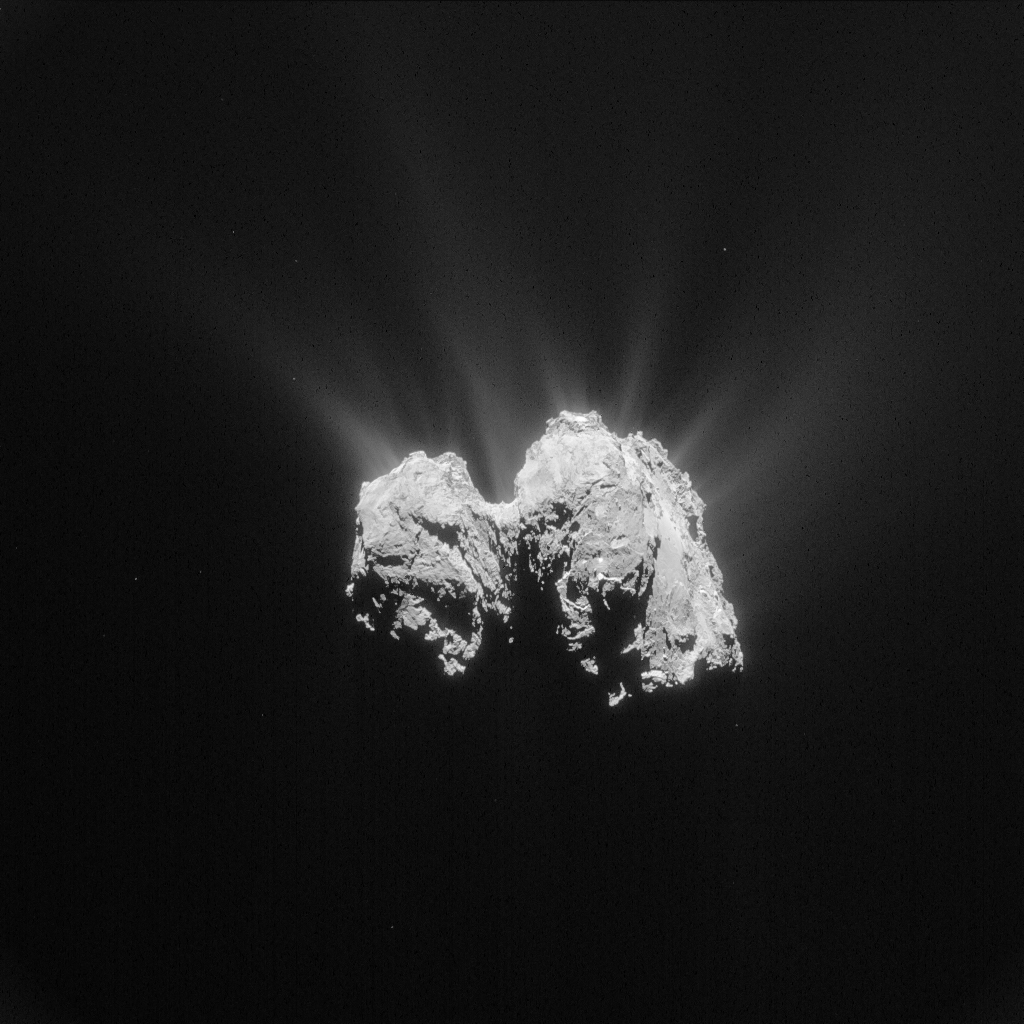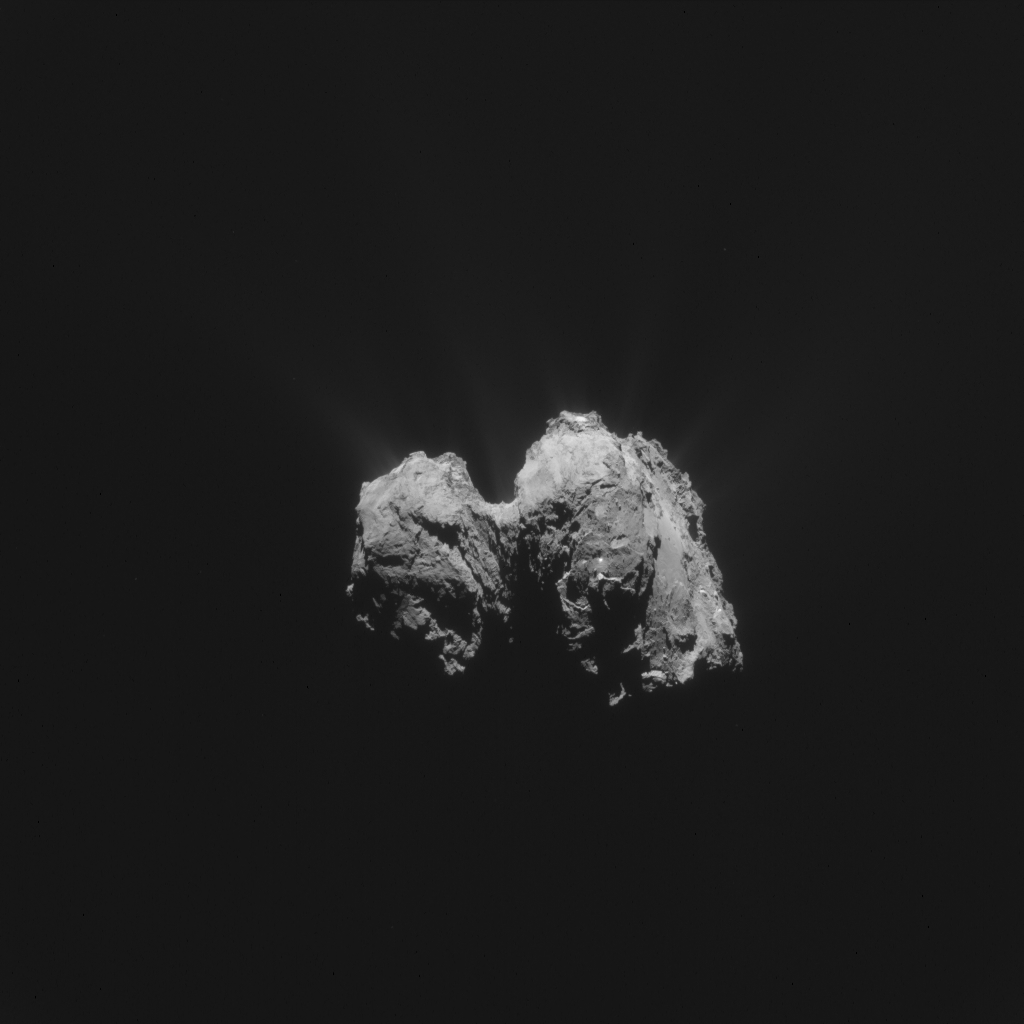This image of Comet 67P/Churyumov-Gerasimenko was taken by Rosetta’s NAVCAM on 3 May at a distance of 135 km from the comet centre. It is a single frame image, with a resolution of 11.5 m/pixel, and measures 11.7 km across. The intensities and contrast have been tweaked to emphasise the ever increasing activity of the comet.

Single frame, processed NAVCAM image of Comet 67P/C-G taken on 3 May 2015 from a distance of 135 km to the comet centre. Credits: ESA/Rosetta/NAVCAM – CC BY-SA IGO 3.0
In this “side-on” view of 67P/C-G, with the small lobe to the left and the large lobe to the right, the equator of the comet runs almost horizontally. The comet equator also passes through the famous Cheops boulder on the Imhotep region, on the underside of the large lobe (visible on the right-hand side of this image) and wraps around both lobes. In this orientation, the rotation axis of the comet runs roughly in the vertical direction, through the comet’s “neck”.
On the small lobe, we see parts of the Bastet region, along with neighbouring regions that were in darkness during earlier parts of Rosetta’s time at 67P/C-G. As the comet approaches the Sun, the “seasons” are changing, so these and other parts of the comet are emerging into sunlight.
Hints of Hathor and Hapi are visible in the distance on the neck. On the large lobe, the slab-like feature comprising parts of Aker and Khepry, featured prominently in CometWatch 26 April and 28 April, takes up the upper part of the image.
In the foreground, the landscape shows some particularly bright spots set against darker terrain, although at this relatively large distance it is not possible to see enough detail and help interpret what they are. To their right, Khepry ends in cliffs that border the curved, smooth region within Imhotep.
The original 1024 x 1024 image is provided below:










Discussion: 21 comments
Maybe too much lakritze. Is this thing ‘puffing’?
The jets are becoming conspicuous even in the raw ‘un-tweaked’ images. Roll on perihelion!
Just a small correction.
I’m fairly sure this image was taken at about
2015 may 3 21:55 UTC.
That’s when my simulated Rosetta best match the image in this navcam frame.
The problem is that the viewing geometry in this description is wrong. Rosetta is NOT looking in from along the equator.
Rosetta is actually about 55 degrees below the equator looking at the comets south pole.
The sun however is shining in from the direction you describe.
Best regards
Mattias
Hi Matthias, thanks for your remark.
The caption meant to provide just a simple indication of the equator running through the comet in the left-right direction (as opposed to other images that show 67P/C-G with either of the lobes pointing upwards).
But indeed, as you point out, the equator does not run through the central part of the image, but closer to the top of the comet in this orientation, and the viewing geometry you mention is correct.
As for the time, the image was taken at about 20:48 UTC on 3 May 2015.
I did my own slipup with the time. I tested a bunch of different times and wrote the wrong one in the post. My best guess was 20:55. I need to refine the rotation of my shapemodel a little…
Any comments Claudia from the scientific team about the nature of the jets, for example the distribution of brightness we see within individual jets and the similarity in brightness from jet to jet; also the consistent size from jet to jet; and any data yet on jet temperature or jet composition.
I notice that the comet and the orbiter will cross the trailing orbit of Mars in about a months time on the 14th June, about 3 months after the passage of the planet. Any effects expected from that. And any damage to the orbiter from its voyage through the asteroid belt that has taken place since the rendezvous until now.
Also coincident with the perihelion in the middle of August there is a linear conjunction between Earth, Venus and the Sun on the same side of the Sun. Any effects in short term solar activity expected from that.
Finally could you confirm that the orbiter will remain at a distance of 135 km plus from the nucleus throughout the perihelion phase and if so when will it return to close in observation and measurement.
Also, by the way Claudia, there was recently, on the morning of the 12th May, a sudden and large increase in density and speed of protons emitted from the Sun which lasted for about a day. It was in the direction of the comet 67P and I estimate should arrive there 4 and a half to five days from then, ie on the 16th/17th May. Any expectations of effects of that event on comet activity.
@originaljohn
“I notice that the comet and the orbiter will cross the trailing orbit of Mars in about a months time on the 14th June, about 3 months after the passage of the planet. Any effects expected from that. ”
Why would there be?
“And any damage to the orbiter from its voyage through the asteroid belt that has taken place since the rendezvous until now.”
Asteroid belt is mostly empty space.
“Also coincident with the perihelion in the middle of August there is a linear conjunction between Earth, Venus and the Sun on the same side of the Sun. Any effects in short term solar activity expected from that.”
Again, why would there be? How would the orbital positions of two particular planets have an effect on solar activity? Earth and Venus come to conjunction on a pretty regular basis. Any coincident increase in solar activity (from mechanisms unknown) would have been noticed by now.
“Finally could you confirm that the orbiter will remain at a distance of 135 km plus from the nucleus throughout the perihelion phase and if so when will it return to close in observation and measurement.”
Close flybys haven’t been scheduled for before October 2015.
In the meanwhile Rosetta may even increase the distance, temporarily maybe up to more than 1000 km. (Up to about 2000 km distance from the nucleus have been scheduled pre-flight).
But usually there is more than one plan, to be prepared for actual conditions.
67p has a sharp occipit.
“The comet’s nucleus today is made up of small rocks and ice, separated by fractions of an inch, that originally formed billions of miles apart. Some rocks have seen temperatures above 2500 degrees Fahrenheit, but adjacent ice has been kept close to absolute zero for billions of years. Every tiny grain we look at has its own fascinating story to tell.”
Interesting perspective from Ryan C. Ogliore et al on comet Wild2.
https://www.sciencedirect.com/science/article/pii/S0016703715002343
Via phys.org
Claudia,
Are you, or anyone else for that matter, know of any comet 67P pictures taken from Earth that are available to the public?
Seems there would be some observatory following up. It would be interesting to compare an Earth based pic with a Robert pic…
Hi WayneC,
You might like to check this post: https://blogs.esa.int/rosetta/2015/04/16/rosetta-ground-based-campaign-comet-67pc-g-recovered-on-13-april/ and follow the links therein for more information and recent images from amateur astronomers.
Maybe cometesimals are not just made by adsorption/accretion/caging/condensation [in that order].
Maybe ‘coagulation’ is relevant also. That is, a ‘foreigner’ dust cloud -carrying a different ‘relativistic’ temperature, averaged electrostatic charge and set of adsorbates- ‘coagulates’ on impacting with a ‘local’ dust cloud.
[Don’t believe slim dust waves or energetic dust jets develop a relativistically uniform temperature, so, only with dense, big dust clouds]
This is cometary fiction.
The latest image of 67P{ is from 11 Aug 2014, almost a year ago.
Why aren’t any observatories following the comet? Or if they are, I’d sure like to see a few recent images.
OOPS, here’s a link to the image https://blogs.esa.int/rosetta/2014/09/08/observing-comet-67pc-g-with-the-very-large-telescope/
See this page for ground based images of the comet
https://www.aerith.net/comet/catalog/0067P/2015.html
Hi Wayne,
The observing geometry from Earth is not a favourable one at the moment for many Northern hemisphere observatories. It is currently best viewed from the Southern Hemisphere and achieves a maximum height of around 20 degrees at the beginning of Astronomical Twilight (@ 31 S lat.) and sits right in the middle of the zodiacal light. The faintness of the comet (currently the total visual magnitude or ‘m1’ is in the mid-15’s), low altitude and zodiacal light interference make it a difficult target. It has been imaged with telescopes with CCD capabilities and requires to get low in altitude. Not many professional observatories like looking that close to the horizon or in those regions of the morning sky, or may have local obstructions which prevent acquisition. Moonlight also interferes and in recent days it has just been able to get out of the way so more images should start to come in soon.
When I was about 14 -15 years old, there was the Sun and nine planets. Now, just look at your fantastic pictures for starters.
By the way, it was already accepted that the Sun was the center
Kind of, John 😉
Could be personal taste, but find myself more comfortable with ‘fountain’, rather than with ‘jet’ word.